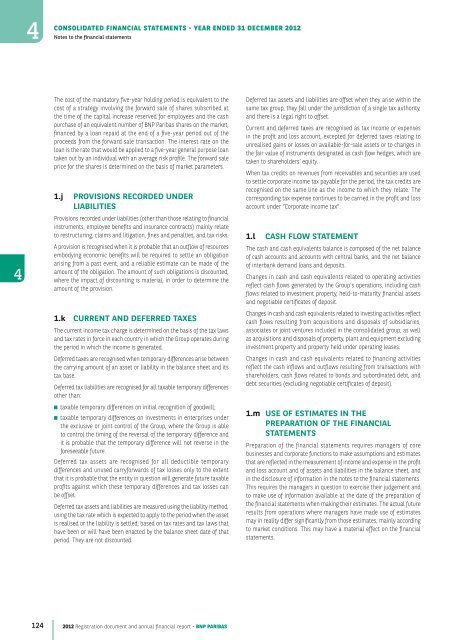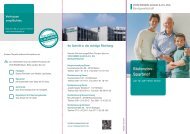2012 Registration document and annual financial report - BNP Paribas
2012 Registration document and annual financial report - BNP Paribas
2012 Registration document and annual financial report - BNP Paribas
- No tags were found...
You also want an ePaper? Increase the reach of your titles
YUMPU automatically turns print PDFs into web optimized ePapers that Google loves.
4CONSOLIDATEDFINANCIAL STATEMENTS - YEAR ENDED 31 DECEMBER <strong>2012</strong>Notes to the <strong>financial</strong> statements4The cost of the m<strong>and</strong>atory five-year holding period is equivalent to thecost of a strategy involving the forward sale of shares subscribed atthe time of the capital increase reserved for employees <strong>and</strong> the cashpurchase of an equivalent number of <strong>BNP</strong> <strong>Paribas</strong> shares on the market,financed by a loan repaid at the end of a five-year period out of theproceeds from the forward sale transaction. The interest rate on theloan is the rate that would be applied to a five-year general purpose loantaken out by an individual with an average risk profile. The forward saleprice for the shares is determined on the basis of market parameters.1.j PROVISIONS RECORDED UNDERLIABILITIESProvisions recorded under liabilities (other than those relating to <strong>financial</strong>instruments, employee benefits <strong>and</strong> insurance contracts) mainly relateto restructuring, claims <strong>and</strong> litigation, fines <strong>and</strong> penalties, <strong>and</strong> tax risks.A provision is recognised when it is probable that an outflow of resourcesembodying economic benefits will be required to settle an obligationarising from a past event, <strong>and</strong> a reliable estimate can be made of theamount of the obligation. The amount of such obligations is discounted,where the impact of discounting is material, in order to determine theamount of the provision.1.k CURRENT AND DEFERRED TAXESThe current income tax charge is determined on the basis of the tax laws<strong>and</strong> tax rates in force in each country in which the Group operates duringthe period in which the income is generated.Deferred taxes are recognised when temporary differences arise betweenthe carrying amount of an asset or liability in the balance sheet <strong>and</strong> itstax base.Deferred tax liabilities are recognised for all taxable temporary differencesother than:■ taxable temporary differences on initial recognition of goodwill;■ taxable temporary differences on investments in enterprises underthe exclusive or joint control of the Group, where the Group is ableto control the timing of the reversal of the temporary difference <strong>and</strong>it is probable that the temporary difference will not reverse in theforeseeable future.Deferred tax assets are recognised for all deductible temporarydifferences <strong>and</strong> unused carryforwards of tax losses only to the extentthat it is probable that the entity in question will generate future taxableprofits against which these temporary differences <strong>and</strong> tax losses canbe offset.Deferred tax assets <strong>and</strong> liabilities are measured using the liability method,using the tax rate which is expected to apply to the period when the assetis realised or the liability is settled, based on tax rates <strong>and</strong> tax laws thathave been or will have been enacted by the balance sheet date of thatperiod. They are not discounted.Deferred tax assets <strong>and</strong> liabilities are offset when they arise within thesame tax group, they fall under the jurisdiction of a single tax authority,<strong>and</strong> there is a legal right to offset.Current <strong>and</strong> deferred taxes are recognised as tax income or expensesin the profit <strong>and</strong> loss account, excepted for deferred taxes relating tounrealised gains or losses on available-for-sale assets or to changes inthe fair value of instruments designated as cash flow hedges, which aretaken to shareholders’ equity.When tax credits on revenues from receivables <strong>and</strong> securities are usedto settle corporate income tax payable for the period, the tax credits arerecognised on the same line as the income to which they relate. Thecorresponding tax expense continues to be carried in the profit <strong>and</strong> lossaccount under “Corporate income tax”.1.l CASH FLOW STATEMENTThe cash <strong>and</strong> cash equivalents balance is composed of the net balanceof cash accounts <strong>and</strong> accounts with central banks, <strong>and</strong> the net balanceof interbank dem<strong>and</strong> loans <strong>and</strong> deposits.Changes in cash <strong>and</strong> cash equivalents related to operating activitiesreflect cash flows generated by the Group’s operations, including cashflows related to investment property, held-to-maturity <strong>financial</strong> assets<strong>and</strong> negotiable certificates of deposit.Changes in cash <strong>and</strong> cash equivalents related to investing activities reflectcash flows resulting from acquisitions <strong>and</strong> disposals of subsidiaries,associates or joint ventures included in the consolidated group, as wellas acquisitions <strong>and</strong> disposals of property, plant <strong>and</strong> equipment excludinginvestment property <strong>and</strong> property held under operating leases.Changes in cash <strong>and</strong> cash equivalents related to financing activitiesreflect the cash inflows <strong>and</strong> outflows resulting from transactions withshareholders, cash flows related to bonds <strong>and</strong> subordinated debt, <strong>and</strong>debt securities (excluding negotiable certificates of deposit).1.m USE OF ESTIMATES IN THEPREPARATION OF THE F INANCIALS TATEMENTSPreparation of the <strong>financial</strong> statements requires managers of corebusinesses <strong>and</strong> corporate functions to make assumptions <strong>and</strong> estimatesthat are reflected in the measurement of income <strong>and</strong> expense in the profit<strong>and</strong> loss account <strong>and</strong> of assets <strong>and</strong> liabilities in the balance sheet, <strong>and</strong>in the disclosure of information in the notes to the <strong>financial</strong> statements.This requires the managers in question to exercise their judgement <strong>and</strong>to make use of information available at the date of the preparation ofthe <strong>financial</strong> statements when making their estimates. The actual futureresults from operations where managers have made use of estimatesmay in reality differ significantly from those estimates, mainly accordingto market conditions. This may have a material effect on the <strong>financial</strong>statements.124<strong>2012</strong> <strong>Registration</strong> <strong>document</strong> <strong>and</strong> <strong>annual</strong> <strong>financial</strong> <strong>report</strong> - <strong>BNP</strong> PARIBAS





